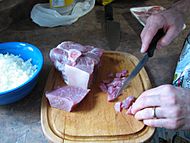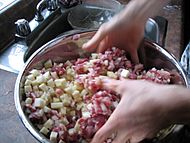Tourtière du Lac-Saint-Jean facts for kids
The Tourtière du Lac-Saint-Jean is a special Québécois dish. It's a type of pie that comes from the Saguenay-Lac-Saint-Jean area in Quebec, Canada. This pie is a bit different from a regular tourtière, which is also a meat pie.
What makes this tourtière unique? It has a much thicker crust and is cooked in a bigger, deeper dish. Inside, you'll find cubes of potato and different kinds of meat. It also has a lot of tasty broth, which makes it very juicy.
The meats usually include pork, beef, or veal. Sometimes, if people can find it, they use wild game like moose, hare, or even ruffed grouse. You might also find chicken cooked with onions in some recipes.
This big pie is made to feed many people, usually at least 10 servings! That's why it's a popular meal for big parties, festivals, and during "le temps des fêtes" (the holiday season in December and January).
The Tourtière du Lac-Saint-Jean is also different from another dish called cipaille. Cipaille is found in places like Gaspésie and Acadia. The main difference is that cipaille has many layers of dough, while this tourtière does not. People in Saguenay-Lac-Saint-Jean often call this specific dish "tourtière." They call other meat pies "pâté à la viande," which means "meat pie."
Where Does the Name Come From?
You might think the name "tourtière" comes from the "tourte voyageuse," which was a type of passenger pigeon. This bird used to be a popular meat for pies, but it is now extinct. However, that's not where the name comes from!
The name "tourtière" actually comes from the special kind of container or dish that these pies were cooked in a long time ago. The very first known recipe for a dish like tourtière is from a book written in the 13th century. It was called Liber de Coquina, and it described a "Torta parmigiana" with many layers of different ingredients.
Gallery









